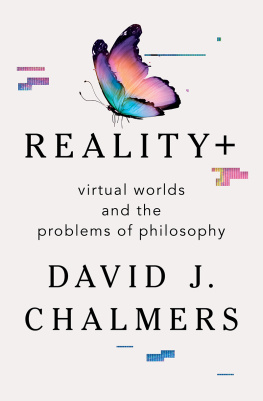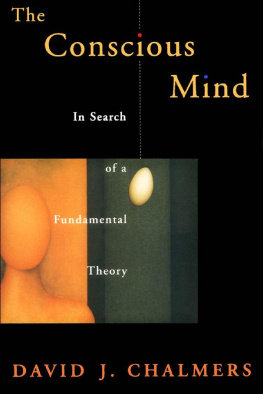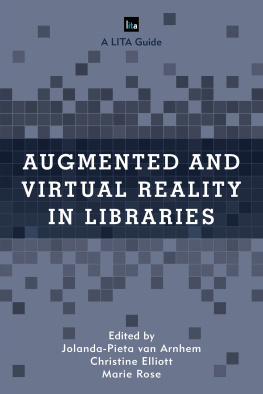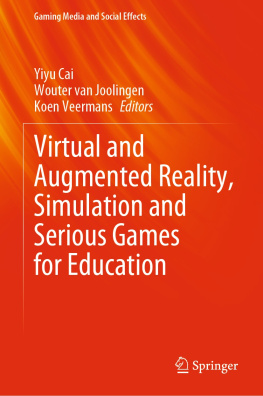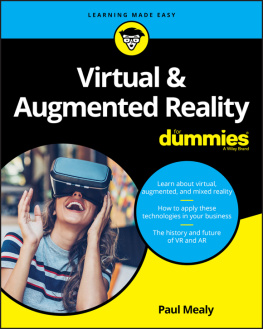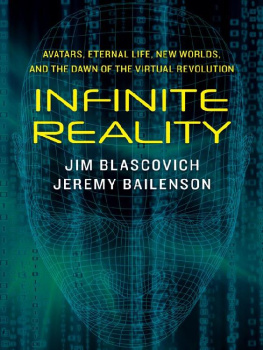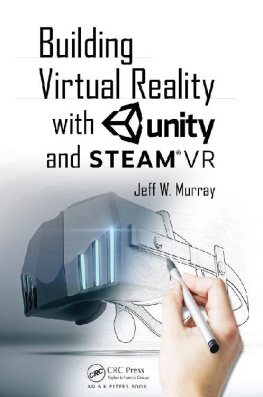BY THE SAME AUTHOR
The Conscious Mind
The Character of Consciousness
Constructing the World
David J. Chalmers
REALITY+
Virtual Worlds and the Problems of Philosophy
Illustrations by Tim Peacock

PENGUIN BOOKS
UK | USA | Canada | Ireland | Australia
New Zealand | India | South Africa
Penguin Books is part of the Penguin Random House group of companies whose addresses can be found at global.penguinrandomhouse.com.

First published in the USA by W. W. Norton and Co. 2022
First published in Great Britain by Allen Lane 2022
Copyright David J. Chalmers, 2022
Illustrations copyright Tim Peacock
The moral right of the author has been asserted
Cover photograph Getty Images
ISBN: 978-0-241-32072-3
This ebook is copyright material and must not be copied, reproduced, transferred, distributed, leased, licensed or publicly performed or used in any way except as specifically permitted in writing by the publishers, as allowed under the terms and conditions under which it was purchased or as strictly permitted by applicable copyright law. Any unauthorized distribution or use of this text may be a direct infringement of the authors and publishers rights and those responsible may be liable in law accordingly.
For Claudia
Introduction
Adventures in technophilosophy
WHEN I WAS TEN YEARS OLD, I DISCOVERED COMPUTERS. MY first machine was a PDP-10 mainframe system at the medical center where my father worked. I taught myself to write simple programs in the BASIC computer language. Like any ten-year-old, I was especially pleased to discover games on the computer. One game was simply labeled ADVENT. I opened it and saw:
- You are standing at the end of a road before a small brick building.
- Around you is a forest.
- A small stream flows out of the building and down a gully.
I figured out that I could move around with commands like go north and go south. I entered the building and got food, water, keys, a lamp. I wandered outside and descended through a grate into a system of underground caves. Soon I was battling snakes, gathering treasures, and throwing axes at pesky attackers. The game used text only, no graphics, but it was easy to imagine the cave system stretching out below ground. I played for months, roaming farther and deeper, gradually mapping out the world.
It was 1976. The game was Colossal Cave Adventure. It was my first virtual world.
In the years that followed, I discovered video games. I started with Pong and Breakout. When Space Invaders came to our local shopping mall, it became an obsession for my brothers and me. Eventually I got an Apple II computer, and we could play Asteroids and Pac-Man endlessly at home.
Over the years, virtual worlds have become richer. In the 1990s, games such as Doom and Quake pioneered the use of a first-person perspective. In the 2000s, people began spending vast amounts of time in multiplayer virtual worlds like Second Life and World of Warcraft. In the 2010s, there arrived the first rumblings of consumer-level virtual reality headsets, like the Oculus Rift. That decade also saw the first widespread use of augmented reality environments, which populate the physical world with virtual objects in games like Pokmon Go.
These days, I have numerous virtual reality systems in my study, including an Oculus Quest 2 and an HTC Vive. I put on a headset, open an application, and suddenly Im in a virtual world. The physical world has disappeared entirely, replaced by a computer-generated environment. Virtual objects surround me, and I can move among them and manipulate them.
Like ordinary video games from Pong to Fortnite, virtual reality (or VR) involves a virtual world: an interactive, computer-generated space. Whats distinctive about VR is that its virtual worlds are immersive. Instead of showing you a two-dimensional screen, VR immerses you in a three-dimensional world you can see and hear as if you existed within it. Virtual reality involves an immersive, interactive, computer-generated space.
Ive had all sorts of interesting experiences in VR. Ive assumed a female body. Ive fought off assassins. Ive flown like a bird. Ive traveled to Mars. Ive looked at a human brain from the inside, with neurons all around me. Ive stood on a plank stretched over a canyonterrified, though I knew perfectly well that if I were to step off, Id step onto a nonvirtual floor just below the plank.
Like many other people, during the recent pandemic Ive spent a great deal of time talking to friends, family, and colleagues using Zoom and other videoconferencing software. Zoom is convenient, but it has many limitations. Eye contact is difficult. Group interactions are choppy rather than cohesive. There is no sense that we are inhabiting a common space. One underlying issue is that videoconferencing is not virtual reality. It is interactive but not immersive, and there is no common virtual world.
During the pandemic, Ive also met up once a week with a merry band of fellow philosophers in VR. Weve tried many different platforms and activitiesflying with angel wings in Altspace, slicing cubes to a rhythm in Beat Saber, talking philosophy on the balcony in Bigscreen, playing paintball in Rec Room, giving lectures in Spatial, trying out colorful avatars in VRChat. VR technology is still far from perfect, but weve had the sense of inhabiting a common world. When five of us were standing around after a short presentation, someone said, This is just like coffee break at a philosophy conference. When the next pandemic arrives in a decade or two, its likely that many people will hang out in immersive virtual worlds designed for social interaction.
Augmented reality (or AR) systems are also progressing fast. These systems offer a world that is partly virtual and partly physical. The ordinary physical world is augmented by virtual objects. I dont yet have my own augmented reality glasses, but companies like Apple, Facebook, and Google are said to be working on them. Augmented reality systems have the potential to replace screen-based computing entirely, or at least replace physical screens with virtual screens. Interacting with virtual objects may become part of everyday life.
Todays VR and AR systems are primitive. The headsets and glasses are bulky. The visual resolution for virtual objects is grainy. Virtual environments offer immersive vision and sound, but you cant touch a virtual surface, smell a virtual flower, or taste a virtual glass of wine when you drink it.
These temporary limitations will pass. The physics engines that underpin VR are improving. In years to come, the headsets will get smaller, and we will transition to glasses, contact lenses, and eventually retinal or brain implants. The resolution will get better, until a virtual world looks exactly like a nonvirtual world. We will figure out how to handle touch, smell, and taste. We may spend much of our lives in these environments, whether for work, socializing, or entertainment.
My guess is that within a century we will have virtual realities that are indistinguishable from the nonvirtual world. Perhaps well plug into machines through a brain-computer interface, bypassing our eyes and ears and other sense organs. The machines will contain an extremely detailed simulation of a physical reality, simulating laws of physics to track how every object within that reality behaves.


